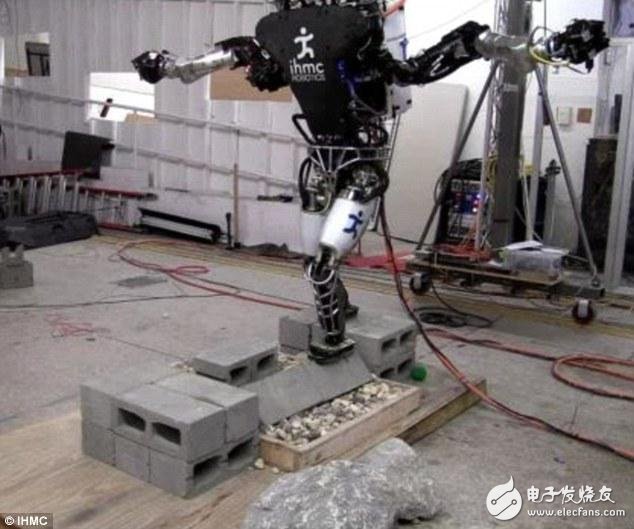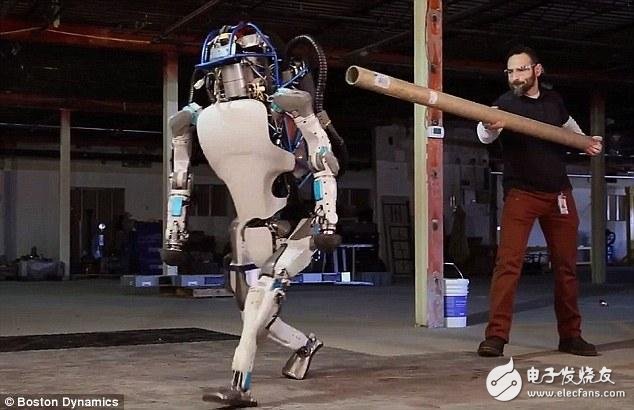According to foreign media reports, the Atlas humanoid robot from Google Dynamics was initially very clumsy, but it is now able to move on complex terrain.
Atlas's algorithm has been upgraded to better balance itself on the rocky ground. This new achievement comes from the Institute of Human and Machine Cognition. The agency said that the robot is currently able to find a solid support point, and then transfer its weight through the wide foot to better support itself.

In the video provided by the Institute of Human and Machine Cognition, we can see that Atlas stretches out his hands to balance, just like the way humans balance. The institute said: "Atlas humanoid robots are walking on a small foothold, such as stepping stones, or a raised straight line. After each step, the robot will find a new foothold and balance its weight. In order to maintain balance, we use angular momentum information every step of the way."
The Atlas robot was developed by Google's Boston Dynamics. This humanoid robot is about 1.8 meters high and weighs about 150 kilograms. The robot is equipped with 28 hydraulic joints and has stereo vision, making it one of the most advanced robots to date.
Boston Dynamics said on the website: "Atlas can walk on both feet, and the upper limbs can pick up things at the same time and cope with the surrounding environment." The video shows that irregular small bricks are laid on the rocky ground, and the robot can stand. These are on small bricks.

Atlas raises a foot and walks on these irregular bricks at an angle and judges whether the foothold is stable. If you think you can achieve a good balance, then the robot will lift the other foot to continue walking.
The robot is controlled manually, but this is not the same as controlling the game with the gamepad. The Human and Machine Cognitive Institute said in a paper published to arXiv: "For balance and walking, estimating the supporting polygons will help. The supporting polygon is an area around the center of the pressure. When walking on an indeterminate terrain Every step of the way requires an analysis of the new foothold. If there is no additional information about the foothold, we assume that the entire sole is in contact with the ground."
The Human and Machine Cognitive Institute said that Atlas will calculate the corresponding pressure center when taking the first foot. If there is no problem in the pressure center, then the other foot will be taken. If the robot believes that the balance is not good, then the support edge will be changed by rotation.
The team also explained the concept of angular momentum. Atlas will gradually add weight to the legs as it steps from a certain angle, forming a “balanced movement similar to the human bodyâ€. Research shows: "This is an important step if you want legged robots to be used in real-world scenarios."
The study also showed: "If you deploy robots in a complex environment, the ability to walk on an unknown foothold will greatly enhance the robustness of the robot. This also greatly expands the environment in which the robot can be competent."
In 2015, Atlas participated in the so-called "Robot Olympics". At the time, the world's most advanced robots carried out a series of challenging activities. The Institute of Human and Machine Cognition observed the process of Atlas walking on complex terrain. But if there is no new algorithm, then the robot will fall after taking a step.

Over the past year, Boston Dynamics has optimized Atlas to be capable of many skills that only humans have. Earlier this year, the company announced that Atlas could climb up on its own after it fell. At the previous "Robot Olympics", Atlas did not have this capability, and a crane was needed to lift the robot.
The video also showed that the robot walked out of the company office and entered a piece of snow. After several encounters, the robot finally stood up successfully. In addition, the robot moved a box weighing up to 10 kg in a very compact environment.
LED Module Outdoor Full Color P10 Module Outdoor LED Display Module using the latest generation technology, 10000dots per square meter. P10 Module Outdoor Full Color with high refresh rate, anti corrosion, anti mildew, anti shock, anti electromagnetic. P10 LED Display Module is one good choice when compare Full Color Outdoor LED Display Module.
P10 outdoor led display is one of the widely used led display in the market now, usually applied in commercial ads, stadium, stage rental......Features:High definition, Light weight, IP65 protection, front maintenance design, high cost performance, 30% cheaper.
1) 10mm for SMD outdoor LED display, good solution for outdoor LED display installation LED display.
2) 10mm is one of the pixel pitches of usual outdoor LED screens. Therefore, it is a very good solution for rental LED display for both outdoor and indoor use.
Salty spray test, high voltage test, varying temperature test, waterproof test, vibration test.Long service time and low attenuation by applying dual channels for heat dissipation.High protection grade of IP65 achieved by patented mask design with waterproof and dustproof fuction.
3) The module size is 320x160mm, which is of our universal module series. It is convenient for clients to promote it. What is more,users can update their old LED displays made of our universal modules easily.
4) Reasonable PCB design with good heat radiation and achieve long life span.
We sincerely invite customers all over the world visit us for cooperation.
Led Screen Module,P10 Module Outdoor,Led Display Outdoor,Led Display Outdoor P10
Shenzhen Jongsun Electronic Technology Co., Ltd. , https://www.jongsunled.com